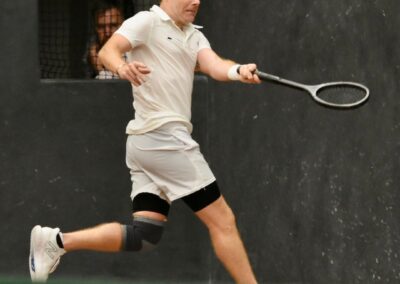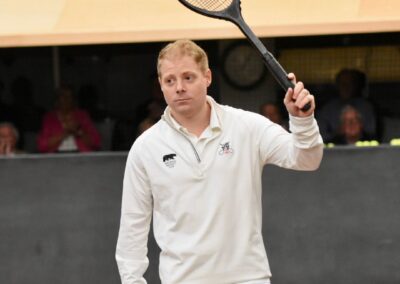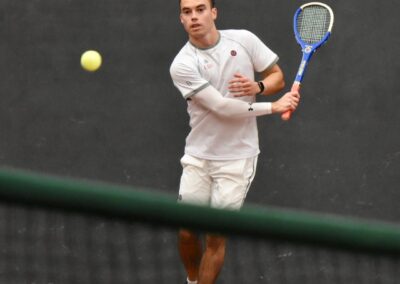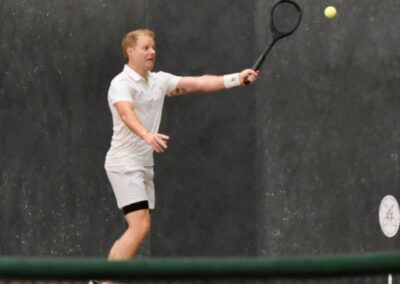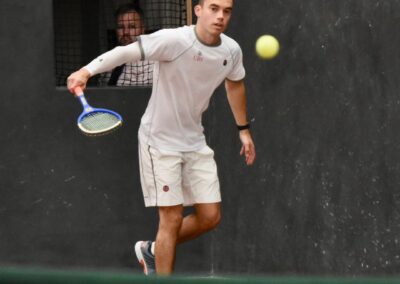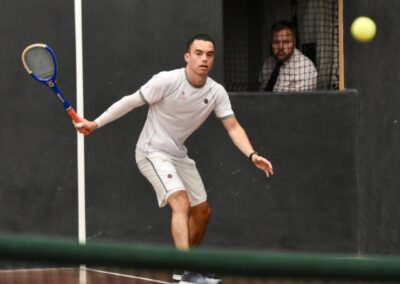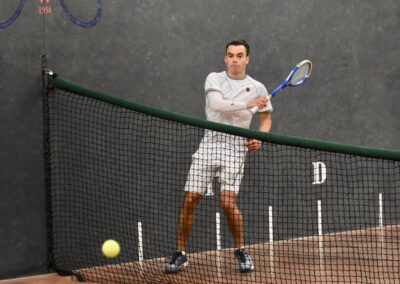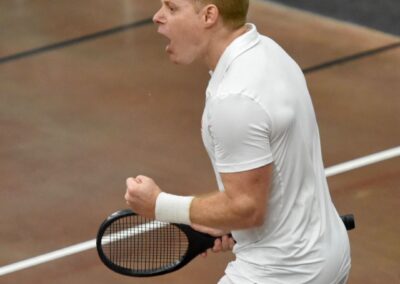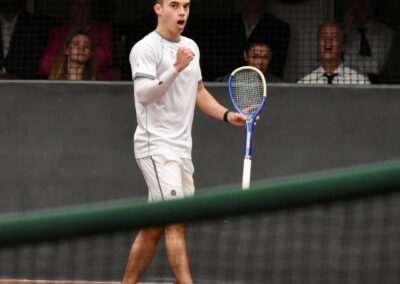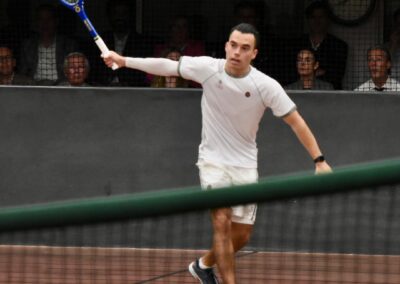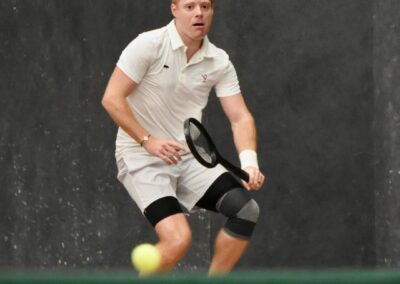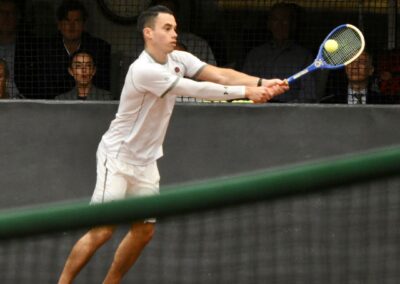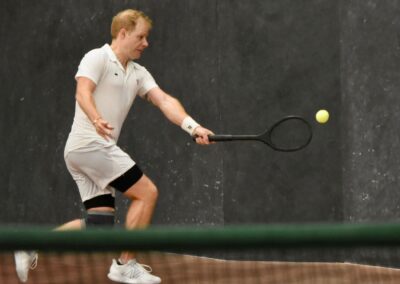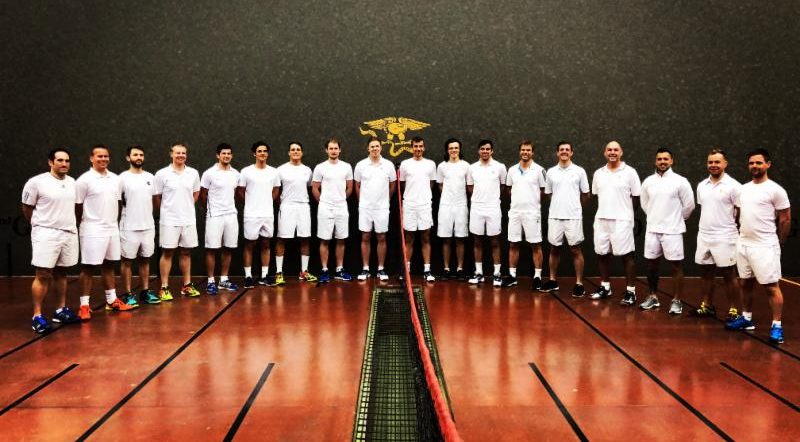By James Zug
Day Two
Lumley won 6-4, 3-6, 6-5, 6-5. The match is now 5-3 in favor of Riviere.
It was an extraordinary Day Two at Westwood, one of the great classic Day Twos in the history of the World Championship, evocative above all of the Day Two at Queens in 2018.
Today the galleries were slightly less dotted by patron gift bags, which were overflowing with local chocolate, the tournament program and two frameable items—the official poster and a Mikko postcard. During the pre-match cocktails upstairs, the canaille enjoyed the two players’ favorite drinks: the Lumley (vodka, pineapple juice, lime juice, sparkling water and a lime) and the Riviere (Sipsmith gin, tonic water and a lime).
From another off-court oubliette, Ryan Carey again streamed the event, his second world championship. Twice in Day Two a player’s force to the dedan dislodged one of Carey’s cameras hanging there like bristling guns in a turret. The championship balls—eighty for the match and sixty for practice—had been made for this Challenge by Darren Long at Manchester, after a thirty-year tradition of Steve Ronaldson making world championship balls. Tim Edwards, the British photographer, was again quietly snapping, as he had each Challenge since 2012. Ivan Ronaldson, the marker, had replaced Andrew Lyons, who had marked every Challenge since 2004. Like Lyons, Ronaldson wasn’t afraid of calling chase off—twice in Day Two that was the result of playing off a chase. Per usual, the whole event was orchestrated by Susie Falkner, the chief executive of the International Real Tennis Professionals Association, who had run the Challenges since 2004. Alistair Curley, the emcee for his fourth Challenge but an observer at every Challenge since 1985, got the second day off smoothly at five o’clock.
Lumley was facing a gigantic uphill task. No player had ever lost the first four sets and come back to win. The best model was Tom Pettitt in 1885 at Hampton Court: Pettitt lost three of the four first sets and then the first two sets on the second day before remarkably reeling off six straight sets to capture the Challenge. Lumley’s racquet hinted at his hope of emulating Pettitt. It was a deep blue Gray’s bat, with yellow accents. On one side it read in large letters Peter Latham; on the other Tom Pettitt.
Riviere, on the other hand (literally), was playing with his all-black Wayward. It was a first for real tennis, as it was the fourth brand of bat he had used in a Challenge (Harrow in 2008; Grays in 2014 and 2018 and 2022; and Gold Leaf in 2016).
Racquets in hand, the players came out looking a little worse for the wear. Riviere had a compression wrap on his left knee and Lumley had athletic tape around his right-hand thumb.
With Riviere dashing to a 3-1 lead, it looked a bit one-sided in South Carolinian’s favor. But Lumley clawed back, taking the next three games. He was playing more decisively, cracking balls into the tambour rather than floating drives to the gallery wall. Still, he wasn’t forcing much: just two balls into the dedans and two into the grille versus six dedans, three grilles and one winning gallery for the Riviere. Down 3-4, Riviere blew a 40-0 lead, squandering four game balls before clinching the game. Then Lumley grabbed the next two games in a hurry, getting his first set in the match.
The sixth set: This time Lumley was the one who jumped to a 3-1 lead and then lost it. Riviere ripped off six games in a row, taking the set with relative ease. Lumley wasn’t serving particularly well—sometimes he overhit his railroad and it bounced off the back penthouse and then the side penthouse, giving Riviere an easy volley for length to the main-wall corner; and his second serve, often a demi-pique, was sometimes too long and Riviere was able to turn on it and smack a forehand. Lumley had trouble finishing off games, giving up eight game points. Riviere, as slippery as an eel covered in Vaseline, could not be pinned down in the corners but managed to again and again escape when retrieval looked impossible. The tail of the tape: five grilles and four dedans for Riviere; two of each for Lumley.
After two reasonable sets—each just over thirty-five minutes—it deepened into the heart of the match. Set seven saw incredible tennis, long point after long point, openings just barely missed. Riviere was up 3-1 and 4-2. Lumley then hit three grilles in one game to peg one game back. Riviere took the next to be up 5-3. It wasn’t going smoothly for him, though. His movement was clearly hampered—a stiff knee, a sore hip, something. He wasn’t flying into the corners as much. He was not finishing off games, squandering nine game balls during the set. Riviere had that first-mate-on-the-bridge-after-a-storm look—beleaguered and bedraggled. At 5-4, he slipped onto the floor. The set went to 5-5, fifteen all, tension thick in the air. Then, 30-15 for Lumley and an epic point ensued with superlative shotmaking. And Lumley finished it off to ensure a Day Three. Nine dedans, seven grilles and a winning gallery for Riviere; three grilles and one dedan for Lumley.
The last set looked surely to be Lumley’s. As cool as a north wind in winter, Lumley flew to a 4-0 lead (the first three games took under ten minutes total). That meant he had won seven straight games, a skein of excellence that suggested the set was finished. But not so. Riviere summoned great courage and battled back. He smacked three dedans forces in a single game. The set stretched for well more than an hour. Two amazing games occurred, at 4-3 and 5-4. In both, each player saved multiple game balls (Riviere saved four in each, including blowing a 40-0 lead down 5-4 before taking the game). At one point Riviere slipped again, jamming his foot against the battery wall. Again, an eleventh game. Again roars from the crowd, ululating, clapping, cheering and racquets-like exhortations. During one set point, playing off chase second gallery, Riviere boldly cannoned a drive into last gallery. But Lumley calming clinched the next one. Riviere: five dedans and three grilles; Lumley six grilles.
Unlike the exciting Day Two at Queens five and a half years ago, here the points were much longer, with both players retrieving like mad; probably less strategy and less decisiveness on the serve; and certainly less forcing to the openings. It made for mesmerizing tennis.
Now, after more than six and a half hours of play, the match hangs in the balance.
Photos by Tim Edwards


